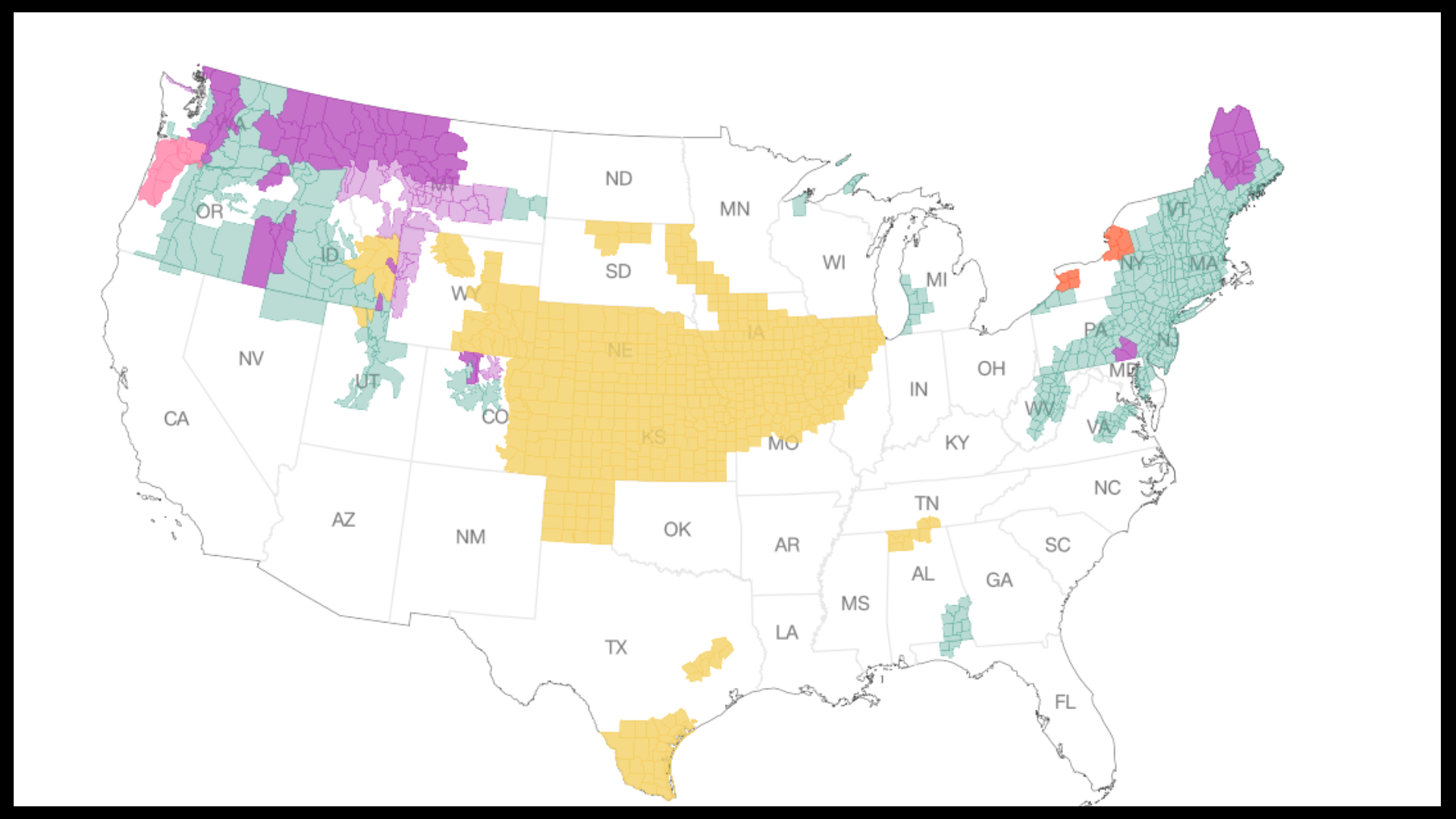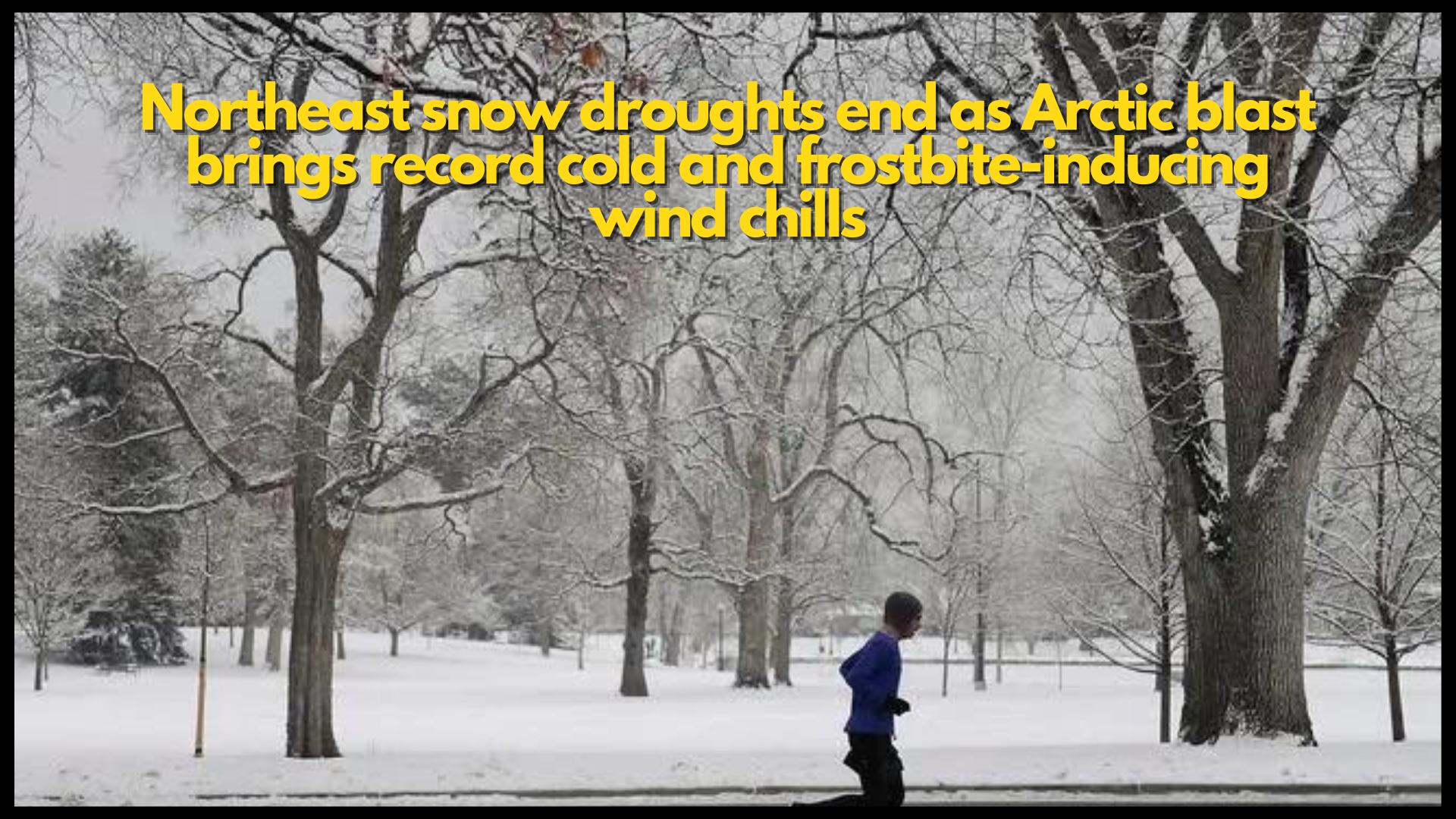• Record snowless streaks end: snow fell in New York City, Philadelphia, Baltimore, and Washington, DC, ending almost two-year waits for an inch of snow. All of the cities reported at least one inch of snow in 24 hours, which had not happened in more than 700 days. The streaks were record-breaking at Baltimore, New York, Philadelphia, and Dulles International Airport in Washington, D.C.
• Record-breaking cold temperatures: By late this week, about 80% of the United States will experience temperatures below freezing. Several day-long cold records have already been set, notably in Texas, Oklahoma, and Kansas, and more may be broken Tuesday across the central and southern United States. Temperatures in Memphis, Dallas, and Nashville are forecast to remain below freezing for at least 72 hours.
• Frostbite may occur in minutes: More than 120 million people are under wind chill warnings from the Canadian to the Mexican borders. Much of the Rockies, Great Plains, and Midwest will see life-threatening subzero wind chills through Tuesday, with wind chills below -30 degrees in the Central Plains and Middle Mississippi Valley. “These wind chills could cause frostbite on exposed skin in a few minutes and hypothermia shortly thereafter,” the National Weather Service advised.
• At least five deaths in many states: Since January 12, back-to-back winter storms have pounded the United States with deadly wind, ice, and snow, resulting in deaths in Arkansas, Oregon, Mississippi, and Tennessee. According to Arkansas state police, one person was killed and another injured after their pickup vehicle careened off a snowy White County roadway and collided with a tree.
• Icy roads make travel dangerous: On Tuesday morning, at least a half-dozen southern states reported wintry conditions on their highways. Crashes on a sloppy I-10 in southern Louisiana shut down a large length of the roadway in both directions Tuesday morning. Transportation officials around the region asked people to stay at home and off the roads as they worked to fight the conditions. “Hundreds” of travel incidents occurred on Tennessee highways on Monday, according to the state’s Department of Transportation.
• Schools and government offices are closed: More than half a dozen states, including Alabama, Louisiana, Mississippi, Texas, and West Virginia, have declared closures due to the freezing weather. Because of the weather, federal government offices in Washington, DC, were closed for the first time since January 7, 2022.
Where to expect snow in the days ahead
Here’s the total snowfall the National Weather Service predicts will fall in the contiguous United States.

Snow and freezing rain pour into the Northeast.
As dangerously low temperatures persist throughout most of the United States, with more than 100 million people in 40 or more states under winter weather alerts, snow and freezing rain in the South extended to the mid-Atlantic, Northeast, and New England through Tuesday.
Heavy lake-effect snowfall is likely to cause substantial traffic disruptions downwind of the Great Lakes. Lake Effect snow occurs when cold air travels across the open, unfrozen waters of the Great Lakes, creating narrow bands of 2 to 3 inches of snow per hour or more.
Buffalo, New York, is under a lake effect snow warning from Tuesday afternoon until Thursday evening, with 1 to 3 feet of snowfall and gusts up to 40 mph likely. Watertown, which is also under a winter storm watch until early Friday, may receive 2 to 3 feet of lake-effect snow.
“Travel might be extremely difficult or impossible. The National Weather Service office in Buffalo advised that areas with blowing snow might considerably decrease visibility. “The hazardous conditions could impact the Wednesday morning and evening commute.”
This region had just received more than 3 feet of snow from a prior bout of significant lake-effect precipitation.
New York City is predicted to receive 2-4 inches of snow on Tuesday, after not receiving an inch of snow in a single day in almost 700 days.
Washington, D.C., was expected to receive at least 4-6 inches of snow by Tuesday. The city received more than an inch of snow on Monday, breaking a stretch of 673 days without at least an inch of snow.
Philadelphia also ended its snow drought, with 1.5 inches dropping as of early Tuesday after 715 days without any snowfall.
As the Northeast contends with heavy snow, another storm will come ashore over the Pacific Northwest on Tuesday and Wednesday as the area recovers from a destructive storm late last week.
An ice storm warning is in effect for more than 3 million people in the region, including Portland, with freezing rain expected in the late afternoon, close to the evening commute. Enough ice might build up to cause damage to trees and electricity lines, risking power outages. The system will also bring rain from the Pacific Northwest into California, with snow at higher elevations.
Where to expect snow in the days ahead
Here’s the total snowfall the National Weather Service predicts will fall in the contiguous United States.

Subzero wind chills and the risk of frostbite
Wind chill readings, which measure how cold people feel outside based on heat loss from exposed skin, are forecast to reach dangerously low levels, causing frostbite and hypothermia.
Through Tuesday, dangerously severe wind chills of 40 degrees below zero are forecast in Illinois, Missouri, and Iowa, as well as 25 degrees below zero in Texas and the Oklahoma Panhandle. “The dangerously cold wind chills could cause frostbite on exposed skin in as little as 10 minutes,” the weather agency advised.
Fingers, toes, earlobes, and the tip of the nose are the most vulnerable to frostbite, according to the weather service. Symptoms include a lack of sensation in the extremities and a whitish or pale complexion.
“Avoid outside activities whenever possible. If you must be outside, dress appropriately, in layers, and cover any exposed skin. “Keep pets indoors,” the National Weather Service said. “Have a cold survival kit if you must travel.”
While temperatures are forecast to decrease by midweek, the weather service predicts a new wave of colder air to arrive across the northern Plains, Midwest, and Deep South by the end of the week.



